Abstract
Multi-temporal Interferometric Synthetic Aperture Radar technique (MTInSAR) has emerged as a valuable tool for measuring ground motion in a wide area. However, interpreting displacement time series and identifying dangerous signals from millions of InSAR coherent targets is challenging. In this study, we propose a method combining stacked autoencoder (SAE) and convolutional neural network (CNN) to classify InSAR time series and ease the interpretation of movements. The InSAR time series are classified into five categories, including stable, linear, accelerating, deceleration, and phase unwrapping error (PUE). The accuracy of labeled samples reaches 95.1%, reflecting the performance of the proposed method. This method was applied to the InSAR results for Kunming extracted from 171 ascending Sentinel-1 images from January 2017 to September 2022. The classification map of the InSAR time series shows that stable coherent points dominate around 79.28% of the area, with linear patterns at 10.70%, decelerating at 5.30%, accelerating at 4.72%, and PUE patterns at 3.60%. The results demonstrate that this method can distinguish different ground motion features and detect nonlinear deformation signals on a large scale without human intervention.
1. Introduction
In the past two decades, multi-temporal InSAR (MTInSAR) techniques have been used to extract surface displacements over coherent targets (CTs) and thus to invert geophysical parameters and monitor the stability of infrastructures and landslides [1,2,3,4]. This approach allows for large-scale displacement mapping, providing access to millions of point-wise time-series (TS) data that can be utilized for stability analysis. Such massive datasets of measurement points pose great challenges to identifying anomalies from displacement time series.
The common approach to cluster time-series displacements and detect anomalous signals is to compare the displacements with a predefined displacement model using statistical model selection, such as linear regression [5], statistical tests [6], wavelet analysis [7], and probabilistic multiple hypothesis testing [8]. Although effective, limited predefined models make it difficult to describe complex deformation in the real world. Bovenga et al. [9] introduce a new statistical test based on the Fisher distribution to get a reliable polynomial approximation of each time series with a minimum degree, thus automatically detecting nonlinear pre-failure warning signals. Refice et al. [10] further introduce fuzzy entropy, which measures the disorder in a time series, to recognize nonmodeled displacement trends. However, the identification performance of statistical methods is easily affected by the phase noise inevitable in the InSAR time series, such as atmospheric artifacts and topographic errors. Assigning a specific displacement model to a single time series does not scale well to big data.
Recent works have explored machine-learning (ML) approaches to handle massive InSAR data [11,12,13,14] and identify abnormal InSAR time-series displacement signals [15]. Ansari et al. [16] and Martin et al. [17] proposed a deep long short-term memory (LSTM) autoencoder model and a deep temporal clustering (DTC) algorithm respectively to learn and cluster time-series displacements. A method for monitoring surface deformation was proposed by van de Kerkhof et al. [18] using t-distributed stochastic neighbor embedding (t-SNE) dimension reduction and density-based clustering non-parametric algorithm (DBSCAN) clustering. Festa et al. [19] employed principal component analysis (PCA) to reduce data dimensionality, while Rygus et al. [20] utilized the uniform manifold approximation and projection (UNWAP) method for the same purpose. Subsequently, both researchers applied clustering algorithms such as hierarchical density-based spatial clustering of applications with noise (HDBSCAN) and k-means to conduct cluster analysis on InSAR time-series data. This approach enhanced the interpretability of InSAR time-series products. However, the results of unsupervised clustering are greatly affected by initial parameters and need expert knowledge for interpretation. Bidirectional long short-term memory (BiLSTM) classification models are employed to identify anomalies like abrupt changes in mutation and mutation rates on coherent scatterers [21]. Mirmazloumi et al. [22] trained a supervised ML model using 5000 reference samples to classify InSAR time series into five deformation trends: stable, linear, quadratic, bilinear, and phase unwrapping error. Customized features, such as the variance, standard deviation, skewness, and kurtosis, are also added to enhance the classification performance. Increased feature work and manual intervention affect the usability of the model and magnify the possibility of model errors.
In this paper, we combine an optimized stacked autoencoder (SAE) with convolutional neural networks (CNN) to identify various behaviors in InSAR time series, such as linear, decreasing, and increasing. The hybrid model leverages the unique strengths of SAE and CNN, providing a framework for the comprehensive analysis of InSAR data. The optimized SAE plays a crucial role in this methodology by utilizing deep features extracted from the InSAR time series. In the context of the InSAR time series, these deep features represent nuanced patterns associated with different deformation behaviors. Specifically designed to address the challenges posed by noise, SAE reduces the influence of noise in the data. This reduction not only improves the classification performance but also enhances the generalization capabilities of the model. By focusing on the most relevant features and ignoring irrelevant noise, SAE contributes to the overall robustness of our approach. Complementing the feature extraction capabilities of SAE, CNN is introduced to capture displacement trends at different scales within the time series. The layering and sliding convolution windows employed by CNN enable the model to effectively discern spatial patterns and trends, contributing to an enhanced feature representation. The combination of SAE and CNN enhances the InSAR time-series data analysis, making it comprehensive and efficient. This collaborative approach elevates the depth of analysis, providing a nuanced understanding of complex patterns within InSAR time-series data. For a detailed exploration of our methodology, including the roles of SAE and CNN, please refer to Section 2. Section 3 provides an overview of the study area and dataset used. In Section 4, we present the results and assess the performance of the proposed methods. Then, the limitations and suggestions are given in Section 5. Finally, in Section 6, we conclude with some remarks.
2. Materials and Methods
This paper focuses on classifying the displacement time series by the proposed SAE–CNN method. The displacements are firstly retrieved by MTInSAR with a series of SAR images. Then, the SAE is optimized by a back propagation neural network (BPNN) with a softmax classifier for feature extraction. The workflow of this study is illustrated in Figure 1.
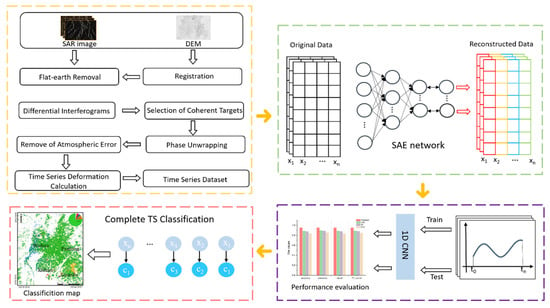
Figure 1.
The framework presented in this paper.
2.1. Predefined Types of Displacement Time Series
Five typical deformation trends, i.e., stable, linear, accelerating, decelerating, and phase unwrapping error, are selected and labeled from MTInSAR time-series data. Typical samples of five TS classes are shown in Figure 2. We labeled 5000 samples through manual visual interpretation and repeated comparison and cross-checking containing five types with 1000 samples in each category. Of these samples, 70% are used for supervised learning of the model of each class, while the remaining 30% are used for validation. Details of five TS classes are given below.
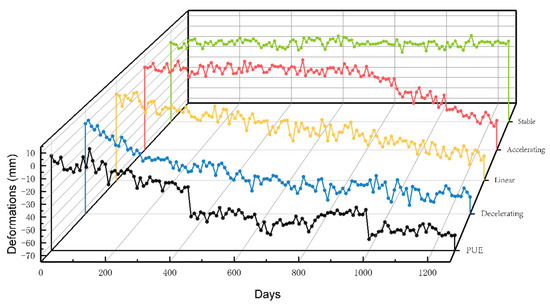
Figure 2.
Typical samples of five TS classes.
- Stable: This trend represents areas where no significant deformation is observed. This class contains non-moving targets (green points in Figure 2).
- Linear: This class contains points with deformation that constantly increase or decrease over time. These points have a constant velocity in the time series (yellow points in Figure 2).
- Accelerating: The accelerating class shows continuous movements and can be characterized by an increasing deformation rate in the time series (red trend in Figure 2). The deformation time series can be approximated by two linear sub-periods with different rates or a second-order polynomial.
- Decelerating: The decelerating displacement class is also nonlinear, with a decreasing deformation rate over time. The final deformation rate can be reduced to zero, that is, stable.
- Phase unwrapping error (PUE): This trend includes TS affected by abnormal deformation jumps caused by PUE in InSAR processing (black points in Figure 2). The PUE value, a multiple of half the wavelength, approximately 28.3 mm in Sentinel-1 SAR images, may change with the noise. TSs affected by vertical jumps greater than 15 mm are classified as PUE [23].
2.2. The Classification Network That Combines the Optimal SAE and CNN
SAE is an efficient method for solving the problem of analyzing and interpreting complex, high-dimensional data. Traditional autoencoder (AE) formed the foundation for SAE. Autoencoder is a type of artificial neural network that can understand the underlying distribution of a dataset by learning to reconstruct the data from a transformed version of it. This provides better feature descriptions than the original data. Mapping the input vector to the hidden layer vector is called encoding, while decoding means reconstructing the hidden layer vector into the initial input vector. Using a single AE for dimensionality reduction and feature learning was limited by the risk of excessive information loss during compression when applied to complex, high-dimensional datasets. SAE represents an expansion and improvement of the primary AE method, aiming to alleviate the problem of information loss during compression.
The SAE algorithm uses a greedy algorithm to pre-training layer by layer and takes the compression characteristics of the hidden layer of a trained AE as the input of the next layer of the AE [24]. After multiple AE stacks, the data obtained from the last network compression is taken as the feature vector to be extracted. This results in the essential characteristics of the data becoming more prominent as the dimensions of the data decrease. The purpose of using stacked deep autoencoders is to help the encoder extract more profound data features, reduce the impact of noise interference, and decrease the computational burden when dealing with complex InSAR time-series datasets. In our proposed model, we use a BPNN with a softmax classifier to improve the SAE and make the dataset generated by the decoder more similar to the actual data. Therefore, the extracted deep features can match the original data to the greatest extent and improve the performance of the classification model. Table 1 covers some of the SAE hyperparameters.

Table 1.
Hyperparameters of SAE.
The forward propagation algorithm is used to calculate the loss function of the optimized SAE. The mean square error function is used to calculate the reconstruction error of the SAE, that is, the error of the output of the decoder and the input of the encoder. The error function is as follows:
where w is weights; b is bias; hw,b(x) is network output; y is unbiased output.
For the dataset which is composed of m training examples, the total reconstruction error function is as follows:
In the supervised learning part, we choose the cross-entropy loss function to calculate the classification error of the classifications results of the softmax layer and the label of the training dataset. The specific formula is as follows:
where k is the number of categories of the InSAR classification data. When class c and sample i have the same class, yic is 1, otherwise 0 is taken. pic is the prediction probability of observation sample i belonging to category c.
The total error of the optimized SAE training process is the sum of J1 and J2.
In each iteration, in order to minimize J, the back propagation algorithm is used to update the network parameters (w, b). The calculation formula is as follows:
where and are partial derivatives of J. is the learning rate. l is the calculated l-th layer network.
During iteration, it is necessary to select an appropriate optimizer according to the characteristics of the dataset. In this paper, we use the Adam optimizer. It introduces momentum and adaptive learning rate at the same time to speed up the convergence, which can make the weight converge to the optimal interval more quickly [25].
After performing feature dimension reduction with the softmax classifier, we obtain an enhanced dataset which is then input into the CNN network for training. Our 1D-CNN (one-dimensional) model is trained using the Adam optimizer, with an initial learning rate of 0.0001. The model is trained for 500 epochs with a batch size of 64, using the cross entropy loss function. Our 1D-CNN model consists of two convolution layers, utilizing a convolutional kernel of size 3 × 3. The extracted features from the stacked autoencoder are fed as input to the 1D-CNN, and the output is one of five deformation classifications. In our CNN, all convolution and pooling operations are one-dimensional. The one-dimensional convolution operation is defined as follows [26]:
where x is the input feature map and y is the output feature map of the current layer. N is the total number of input feature maps. w and b are convolutional kernel and bias vector, respectively. *(●) and f(●) are vector convolution and activation function, respectively.
We used the rectified linear unit (ReLu) function for all convolution layers and added a batch normalization layer after each convolution layer in our 1D-CNN model [27]. The batch normalization layer contributes to the stability of the training process, facilitates the learning of meaningful features, and enhances the overall performance of the model in dimensionality reduction and classification tasks. Table 2 illustrates the parameters and output size of each layer in our 1D-CNN model. To prevent overfitting of our model, we used dropout and an early stop mechanism. After all convolutional layers except the first one, we added the dropout layer to the 1D-CNN model, with the probability of the dropout layer set to 0.5. We monitored the validation set’s performance during the training process and stopped training when it began to decline to prevent overfitting by using early stopping.

Table 2.
Parameters of our 1D-CNN model.
Figure 3 shows the overall architecture of our optimized SAE and CNN models. We use a stacked autoencoder to extract high-level features from the input InSAR data to attenuate the effect of noise and enhance the feature representation of the network, and then feed the extracted feature vectors into a convolutional neural network to input a convolutional neural network for the classification of the temporal data. All the data input to the network has been preprocessed with the machine learning library Sklearn, including data preparation, cleaning, data normalization, training/test splitting, etc. The number of samples in each category is the same, but we increase the weight for the categories of specific deformation patterns (linear, acceleration, deceleration), thus increasing the sensitivity of the model to abnormal deformation signals. Our approach aims to utilize the nonlinear feature extraction of SAE and the powerful classification capability of CNN to achieve efficient and accurate classification of InSAR time-series data.
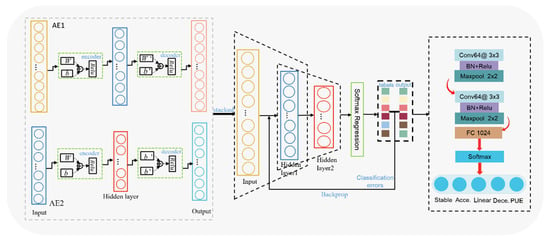
Figure 3.
The structure of the proposed optimized SAE and CNN.
2.3. Accuracy Assessments
Since InSAR TS classification is a multi-classification task, we utilized confusion matrix, precision, recall rate, and F1-score to evaluate the classification performance of the algorithms. The number of positive categories predicted to be positive in the classification result is denoted by TP (true positive), the number of negative categories predicted to be negative is denoted by TN (true negative), the number of negative categories predicted to be positive is denoted by FP (false positive), and the number of positive categories predicted to be negative is denoted by FN (false negative) [28].
Overall accuracy is a metric used to evaluate classification models. It is defined as the ratio of the number of samples correctly classified by the classifier to the total number of samples:
Precision measures the accuracy of positive predictions made by a model. It is defined as the ratio of true positive predictions to the total number of positive predictions made by the model:
Recall, also known as sensitivity or true positive rate, measures the model’s ability to identify all relevant instances from a given class.
The F1-score is a single metric that balances precision and recall. It is the harmonic mean of precision and recall and provides a comprehensive measure of a model’s performance:
where TPi, FPi, FNi, are true positive, false positive, and false negative of class i, respectively. c is the total number of classes. c equals to 5 in our classification task.
3. Study Area and Datasets
3.1. Study Area
Kunming is located in the east-central part of the city in the lake basin on the northern shore of Dian Lake. Kunming exhibits an average altitude of approximately 1891 m and is surrounded by mountains to the north, west, and east. As the capital of Yunnan province, the urbanization process of Kunming has been rapid in the past 20 years, and urban land development has increased significantly. Between 2000 and 2010, the area of built-up land in Kunming increased by 120 km2, and between 2010 and 2020, this area further expanded to 540 km2, as seen in Figure 4. The rapid urbanization of Kunming and the expansion of urban land have led to an increase in the risk of urban surface deformation [29].
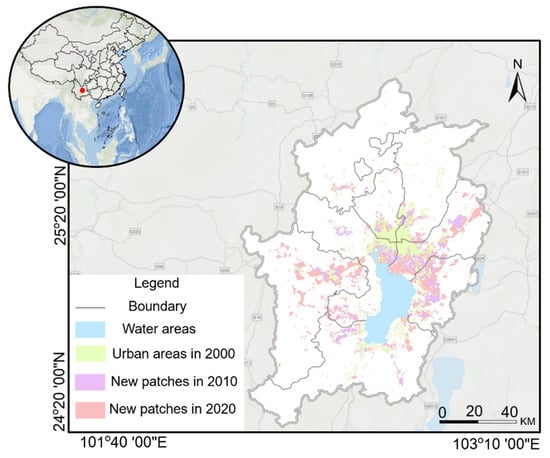
Figure 4.
The urban area of Kunming. The built-up land data are from the China Land Cover Type Monitoring Data provided by the Institute of Geographic Sciences and Resources of the Chinese Academy of Sciences (IGSR).
The presence of Dian Lake makes Kunming a typical lake-phase sedimentary basin filled with large areas of soft soil. In this context, the stratigraphy of Kunming mainly consists of clay, muddy clay, and peaty soils, which are easy to deform under load on the surface [30]. In recent decades, with the growth of population and the expansion of the city, a large scale of construction has been carried out on these special geological environments, causing surface subsidence. Identifying unexpected deformation signals and warning of potential disaster is crucial for protecting the safety of human lives and infrastructures.
3.2. Datasets
We collected 171 ascending Sentinel-1 images from 24 January 2017 to 19 September 2022 in our study area. The spatial and temporal distribution of all images are presented in Figure 5. The image acquired on 17 October 2019 was selected as the master image to ensure high coherence in all interferometric pairs. In InSAR processing, we used the ALOSWorld3D (AW3D30) digital elevation model (DEM) with a 30 m resolution to remove the topographic phase [31]. The time-series displacements were acquired with the Persistent Scatterer InSAR (PS-InSAR) method imbedded in StaMPS Version 4.1b software [32,33].
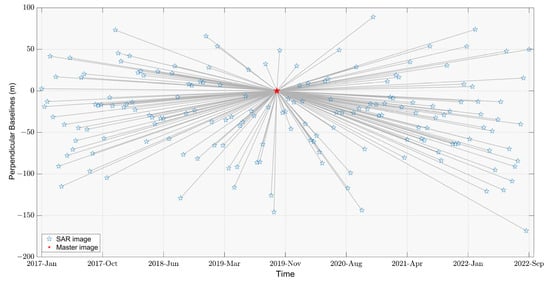
Figure 5.
Spatiotemporal baselines of the ascending dataset.
A total of 561,839 coherent targets (CTs) were obtained after the processing. Figure 6 shows the annual mean displacement velocities from 2017 to 2022. The regions with apparent displacement are mainly concentrated in the lakeside of the Guandu and Wuhua districts, marked with S1, S2, and S3. Within these areas, the maximum accumulative displacement reached −139.70 mm in five and a half years. The spatial distribution and magnitude of the displacements are in good agreement with previous studies [34,35,36].
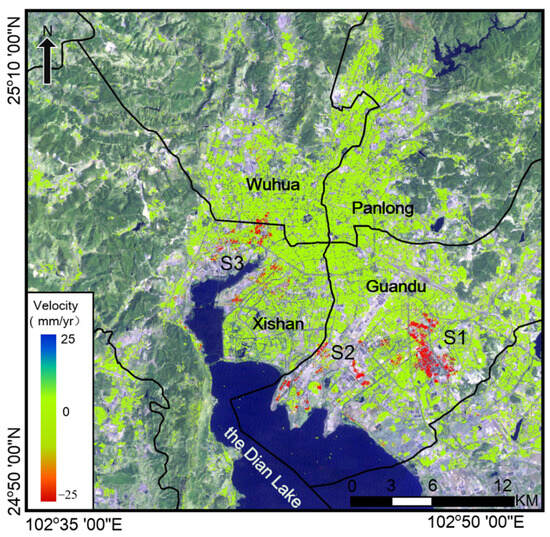
Figure 6.
Surface displacements in Kunming.
S1, located in the area from Guangwei Village to Xiaobanqiao, is one of the areas with the most severe subsidence in the history of Kunming. The maximum displacement velocity reaches −23.8 mm/yr in these years. There was a severe overexploitation of groundwater in this area before 2008. In recent years, many high-rise residential buildings have been built. In S2, the maximum deformation rate was −22.1 mm/yr. Panlong River and Mingtong River flow through this region on their way to Dian Lake. The foundation soil in this area is distinguished by its high water content, limited bearing capacity, and pronounced consolidation and deformation tendencies. With the expansion of construction land in the area, which includes urbanization efforts like the development of the city’s subway system and other urban projects, these regions have experienced more substantial deformation issues. S3 experienced deformation at a rate of −11.2 mm/yr. The deformation in this zone was dispersed, covering several small areas and distributed at the edge of the northern water area of Dian Lake. These regional deformations are attributed to the soil geological characteristics of the Dian Lake, including engineering excavation and construction. The deformation in the main urban area of Kunming is affected by many factors, such as tectonic movement, urban construction, groundwater exploration, and so on. Identifying dangerous abnormal displacement signals from huge amounts of CTs is challenging.
4. Results and Analysis
4.1. Validation of the Proposed Classifier
To compare the reliability of the proposed method, a performance analysis was carried out. Five thousand samples of MTInSAR TS data were labeled with five types of classes: stable, linear, accelerating, decelerating, and PUE (Figure 2). Of these, 30%, i.e., 1500 samples, were used to validate the performance of the proposed classifier. We conducted a series of comparative tests of the proposed model with other classification models, including the Random Forest (RF), Support Vector Machine Classification (SVC), and Convolutional Neural Network (CNN) models. The comparisons with the other three models are presented in Table 3. The experiments show that our proposed model outperforms the other methods in accuracy, precision, recall, and F1-score, achieving the performance of 0.951, 0.953, 0.952, and 0.952, respectively. This indicates that the proposed model can extract classification features from the InSAR time series better than other methods. Overall, the accuracy ratings of the classification models used are above 0.80. As far as the machine learning methods are concerned, the RF results are improved over the SVC model, while the CNN model results are again improved over the RF. Compared to the conventional CNN network, our algorithm gives an improvement of 6.4% in accuracy, 5.6% in precision, 6.5% in recall, and 6.1% in F1 value.

Table 3.
The results of the comparative experiments.
We also provided separate confusion matrix diagrams for each category to analyze the corresponding data samples. Figure 6 displays the confusion matrices for the four models, representing the predicted sample probability per class. The diagonal values represent the sample probabilities of correct classification, while the other cells represent the sample probabilities of misclassification.
From Figure 7, our proposed model achieved an excellent classification effect in InSAR time-series classification. The other three models, RF, SVC, and traditional CNN, exhibited varying degrees of confusion between decelerating and accelerating patterns. RF had the lowest accuracy of 0.81 in identifying decelerating patterns. SVC showed poor performance in identifying accelerating patterns, with only 0.58 accuracy. The experimental results of the confusion matrix show that the proposed model outperforms the traditional SVC, RF, and CNN models in distinguishing different classification categories, especially in recognizing accelerated patterns, with an improved accuracy of 7.7%. The comparative experimental results demonstrate the advantages of the proposed optimized SAE network in dealing with the TS data-classification problem. It extracts deep features and reduces noise, which improves the classification performance of the network and proves its applicability on the TS data-classification task.
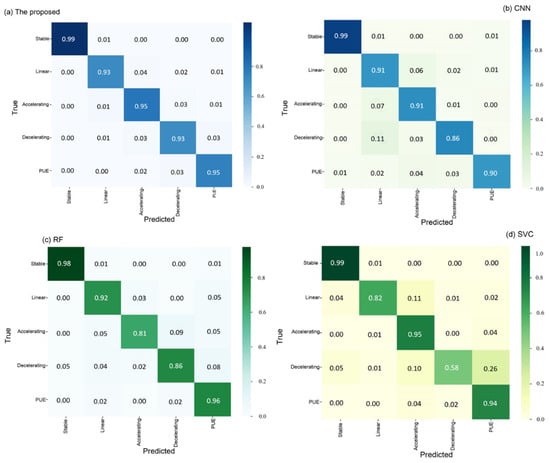
Figure 7.
Confusion matrices for (a) the proposed, (b) CNN, (c) RF, and (d) SVC models, including the number of correct and incorrect classified samples for the five deformation classes.
4.2. SAE Model Analysis
The previous experiments (Figure 7 and Table 3) confirmed enhanced classification performance with the optimized SAE. Since SAE’s feature extraction involves lossy compression, we further investigated the features learned in each encoder. The training loss values are provided throughout network training, and we use the t-distributed stochastic neighbor embedding (t-SNE) [37] technique for feature visualization of the optimized SAE.
As the training process of the optimized SAE network, the network reached stability after 80 iterations of training. Figure 8 shows the loss curve of the network during the training stage. The loss value obtained from Formulas (2)–(4) includes both classification error loss and data reconstruction error loss. As the training progresses, the loss gradually decreases and reaches a plateau on both the training and test subsets. The minimization of the loss function indicates the effectiveness of the network training.
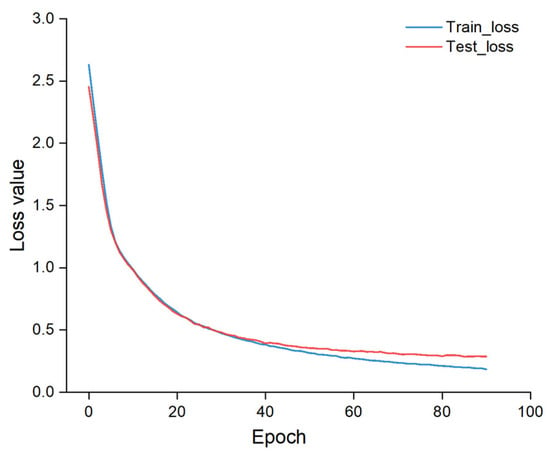
Figure 8.
Training curve of optimized SAE network.
The t-SNE visualization of the original trained dataset and the t-SNE visualization of different encoder layers are shown in Figure 9. Each point in Figure 9 represents a time series projected from high-dimensional features onto a two-dimensional plane. The t-SNE visualizations in Figure 9 reveal a gradual enhancement in InSAR time-series data separability by applying each encoder layer. We can see that it is hard to classify the original trained dataset except for the type of Stable class, while the final feature vector extracted by the optimized SAE becomes easy to classify. The transformation from a challenging classification scenario to an easily classifiable one showcases that optimizing SAE captures underlying patterns in the data and reduces complexity, improving classification results.
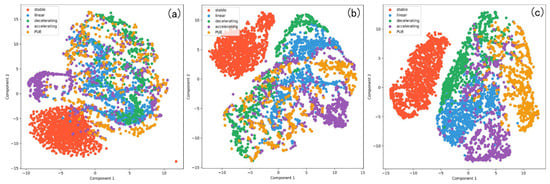
Figure 9.
T-SNE visualization of (a) original trained dataset, (b) middle layer, (c) output layer.
4.3. Classification of the InSAR TS in Kunming
Applying the method described in Section 2.2, Figure 10 displays a TS classification map over the entire Kunming area. The coherent targets TS classified maps provide the spatial distribution of target trends. In our study area, stable CTs dominate approximately 79.28% of the InSAR result, followed by linear (10.70%), decelerating (5.30%), accelerating (4.72%), and PUE patterns (3.60%).
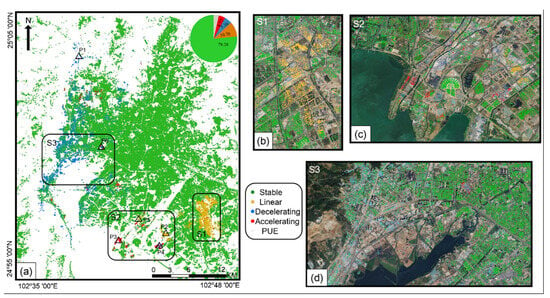
Figure 10.
A classification map obtained by the proposed method over the Kunming city dataset displays (a). The plots in (b–d) show the region of S1–S3.
The CTs time-series classification map of Kunming shown in Figure 10 reveals linear, decelerating, and accelerating deformation patterns on the north bank of the Dian Lake. We focus on analyzing the area with the most severe deformation in the three InSAR results, S1, S2, and S3. S1 exhibited predominantly linear deformation along with some accelerating points. Some green regions with low mean deformation velocity also show linear deformation characteristics in the time series. In S2, mixed linear and accelerating deformations were observed, with a widely distributed and scattered deformation area covering small deformation centers. Figure 10c shows the classification results of the S2 region, highlighting dangerous accelerating deformations in residential areas, such as the residential neighborhoods along Dian Lake (P3). For the points with similar mean velocity, the accelerating points are much more dangerous than the decelerating points. In the region of S3 in Figure 10d, decelerating deformation is the primary type. These classifications distinguish different patterns with similar deformation velocities. The danger of each point can be judged by combining the annual mean velocity. In the next section, we conduct a regional analysis to examine these results.
The supervised classification analysis results are displayed in Figure 11, where the time series corresponds to each cluster. Due to the large amount of data in each category, it was difficult to observe the deformation time series. Thus, 30 records were extracted from the three categories, with the deformation time series presented in Figure 11b. The time series shows the temporal patterns of the clusters and how they differ from each other. Cluster A represents CTs with one-dimensional linear displacement deformation. The deformation pattern in this cluster is relatively uniform in areas like S1 and parts of S3, as indicated by the coherent targets TS classification map. The standard deviation remains relatively stable within these clusters, represented by the shaded areas. Clusters B and C consist of CTs exhibiting accelerating and decelerating deformation. Compared to cluster A, clusters B and C have less uniform standard deviation distributions, with noticeable differences in shadowed areas before and after inflection points. This complexity indicates more variability in accelerating and decelerating deformation areas. Moreover, clusters B and C represent different phases of ground deformation, validating the effectiveness of our proposed algorithm and its agreement with predefined ground motion categories. Cluster A represents a uniform and steady linear ground settlement, while clusters B and C reflect the nonlinear operation of accelerated and decelerated displacements during the deformation process. Cluster B requires continued attention and monitoring as time progresses.
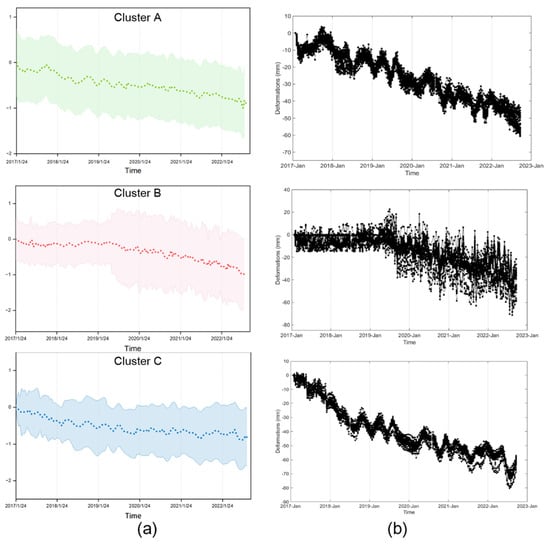
Figure 11.
An average (line) and standard deviation (shadow) of the time series. (a) Clusters corresponding to linear, accelerating, and decelerating classes. The dataset was scaled to the range −1 to 1. (b) Typical time-series samples from three categories with 30 points in each category.
4.4. Analysis of the InSAR Classification Map
The knowledge gained through InSAR time-series classification is a crucial resource in decision-making processes, facilitating proactive measures to mitigate the adverse effects of deformation processes on affected territories. Based on the classification results, we discussed the hazard assessment of the deformation zone in Kunming, considering various factors.
One interesting finding was the observation of decelerating deformation in the area between the Kunming Ring Expressway and the Beijing–Kunming Expressway (P1 cluster) using our proposed algorithm. This finding differed from the results of time-series InSAR, which did not exhibit satisfactory performance (Figure 12a,b). We attributed this discrepancy to the overall regional deformation in this area, where displacements were less significant (−3 and +3 mm/yr) compared to other regions. This suggested potential omissions in monitoring broad regional deformation. However, considering the importance of ensuring subgrade and pavement structure stability and promoting safe highway operation, a thorough investigation of potential hidden issues is crucial. This result underscored the significance and direction of our work, which shows that the proposed method can supplement the interpretation of InSAR results in large areas.
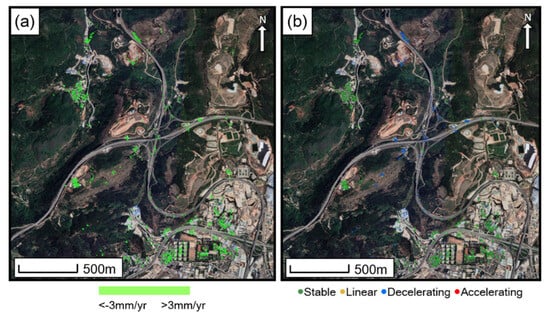
Figure 12.
Zoomed-in view of the (a) deformation rate results and (b) classified map in the Wugui Mountain Interchange (background image from Google Earth Map).
We examined the regions of S1 deformation predominantly classified as linear deformations on our classification map (Figure 13a). Previous studies [34,35] have attributed the historical ground settlement in this area to factors such as over-exploitation of groundwater and the weak permeability of the clayey soil layer. These factors have weakened the foundation, leading to regional deformations. The area is predominantly characterized by clusters of linear deformation. We also observed that the P2 cluster (Figure 13b), which encompasses a residential village in an urban area, displays a pronounced linear deformation pattern. The complex nonlinear deformation signals in the InSAR time-series products can be separated and extracted, as shown by the accelerated cluster represented by the P3 cluster (Figure 13c) in the hinterland of the north bank of the Dian Lake in the S2 region, which also alerts the stakeholders for targeted monitoring. The construction of residential buildings in this area between 2016 and 2019, as indicated by publicly available information (https://zfjs.km.gov.cn (accessed on 27 May 2023)), may contribute to the accelerated deformation process. Factors such as the proximity of the Dian Lake, the short time of sediment formation stratigraphy, low consolidation, high water content, and challenging foundation-bearing capacity likely play a role. The concentration of commercial and residential projects in the region may lead to an increase in surface load, exacerbating deformation. The development of urban infrastructure activities in the area is expected to contribute to more complex deformation trends.
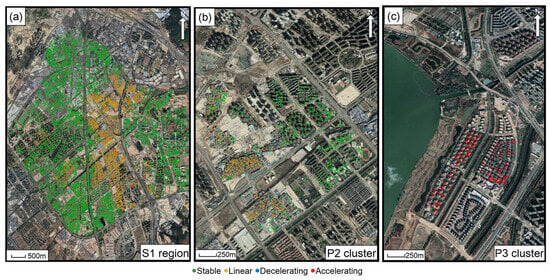
Figure 13.
Classification diagram display of different clusters: (a) the whole S1 region, (b) the P2 cluster, (c) the P3 cluster (background image from Google Earth Map).
In the P4, P5, and P6 clusters depicted in Figure 14, the study identified areas with multiple deformation models. These areas commonly include self-built houses, shantytowns, and ongoing construction operations such as site grading and foundation infrastructure construction. The occurrence of complex deformation patterns in these areas may result from a combination of settlement caused by soil and foundation factors, as well as the presence of non-standard building structures, construction materials, and unauthorized extensions and alterations. The deformation signals in these areas may transition from gradually stable decelerating or uniform linear deformation to more dangerous accelerating deformation. An example is evident in the comparison between Figure 14a and Figure 13b, where P4 demonstrates a diverse deformation pattern compared to P2, despite their proximity. Decelerating deformation, primarily observed along the Dian Lake waterfront in the S3 area, is generally more discrete and has been identified in recent studies [38]. This corresponds to relatively slow or stable deformation trends and can be attributed to the soft and fine-grained soil characteristics of the local lake waterfront. These soils exhibit high water content, high compression, low bearing capacity, and strong consolidation deformation properties. Over time, the bearing capacity of the foundation may gradually recover due to soil consolidation.
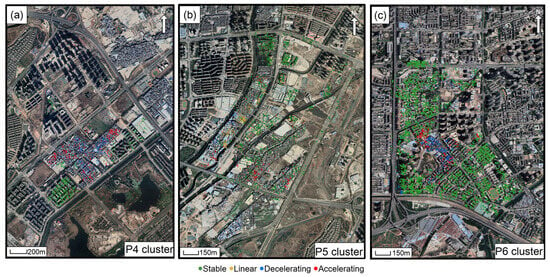
Figure 14.
Classification diagram display of different clusters: (a) the P4 cluster, (b) the P5 cluster, (c) the P6 cluster (background image from Google Earth Map).
5. Discussion
We compared the time cost of different models using an Intel Core i7 machine with 32 GB of RAM and an RTX 1650ti GPU. Table 4 shows the training and testing time for each model on this setup. We evaluate the performance of a CNN model. The CNN exhibited rapid processing capabilities, with a total time of approximately 3.36 s for training and testing after using GPU. RF shows significant efficiency, with a total time of about 1.69 s. Its parallel decision-making process enables it to perform well at tasks that require quick decisions.

Table 4.
Comparison of the time of the different model.
Contrastingly, the SVC classifier displayed considerably longer processing times, requiring approximately 413.46 s for training and testing. The SVC’s time-intensive optimization process seeks to find the hyperplane that maximizes the margin between data points in a high-dimensional feature space, contributing to its longer computation time. We examine the performance of the method proposed in this article. The method achieved a combined training and testing time of 32.18 s. Compared with CNN, adding SAE’s deep feature extraction process increases the processing time. The proposed method combines competitive accuracy with reasonable computational speed by analyzing Table 3 and Table 4. The processing time still needs an improvement to consider the algorithm for carrying out over large datasets. Despite these limitations, the described method performing time-series classification across extensive regions enhances comprehension of deformation patterns and the qualitative interpretation of MTInSAR products.
The selection of stable, linear, accelerating, decelerating, and PUE categories is simplified from real deformation features. While these categories provide a meaningful framework for capturing dangerous deformation signals, they cannot encompass all possible real deformations. Real-world scenarios can be complex. The deformations that do not fit any predefined categories will lead to misclassification. These false alarms can be reduced by using more reference samples with higher quality for model training. Another proven approach lies in using unsupervised forms of clustering exploring unsupervised learning methods to analyze time-series data without labeled training data. However, the results of unsupervised methods are highly dependent on the selection of algorithms and parameters, and face challenges in the interpretation of results.
6. Conclusions
In this paper, we propose a deep learning method combining optimized SAE and CNN to classify InSAR time series and detect anomalous displacement in an urban environment. We employ a BP neural network with a softmax classifier as an improved SAE for the deep feature extraction module. The deep features of the time-series data are automatically extracted by layer-by-layer compression to attenuate the effect of noise on the classification task. Meanwhile, the classification accuracy of the time-series data is further improved with the hierarchical structure of the CNN model and its optimization ability for the classification task. Experimental results demonstrate that the deep features extracted by the optimized SAE can improve the accuracy of the classification task. The corresponding accuracy, precision, recall, and F1-score are 0.951, 0.953, 0.952, and 0.952. Compared with the independent model, the hybrid model based on SAE and CNN performs better in classifying InSAR time-series displacements. We applied the proposed method to analyze 561,893 CTs in Kunming City, Yunnan Province, from January 2017 to September 2022. The results showed that 79.28% of the CTs in this area are stable, while 4.72% are accelerating. The deformation characteristics in several regions with large deformation are analyzed in detail. The results demonstrated that this method can distinguish different types of ground motion features and detect nonlinear deformation signals on a large scale without human intervention.
Author Contributions
Conceptualization, M.L. and M.Y.; Methodology, M.L. and H.W.; Investigation, H.W.; Writing—original draft, H.W. and M.L.; Writing—review & editing, M.L., M.Y. and C.H.; Visualization, H.W.; Supervision, B.-H.T.; Funding acquisition, B.-H.T. All authors have read and agreed to the published version of the manuscript.
Funding
This work was funded by the National Natural Science Foundation of China (Grant Nos. 42230109, 42101450) and the Yunnan Fundamental Research Projects (Grant NO. 202101BE070001-037; 202201AU070104), Interdisciplinary Research Project of KUST (KUST-xk2022005), and the Platform Construction Project of High-Level Talent in KUST.
Data Availability Statement
We thank the European Space Agency (ESA) for providing the Sentinel-1 data.
Conflicts of Interest
The authors declare no conflicts of interest.
References
- Crosetto, M.; Monserrat, O.; Cuevas-González, M.; Devanthéry, N.; Crippa, B. Persistent Scatterer Interferometry: A review. ISPRS J. Photogramm. Remote Sens. 2016, 115, 78–89. [Google Scholar] [CrossRef]
- Li, S.; Xu, W.; Li, Z. Review of the SBAS InSAR Time-series algorithms, applications, and challenges. Geod. Geodyn. 2022, 13, 114–126. [Google Scholar] [CrossRef]
- Li, M.; Zhang, L.; Yang, M.; Liao, M. Complex surface displacements of the Nanyu landslide in Zhouqu, China revealed by multi-platform InSAR observations. Eng. Geol. 2023, 317, 107069. [Google Scholar] [CrossRef]
- Yang, M.; Wang, R.; Li, M.; Liao, M. A PSI targets characterization approach to interpreting surface displacement signals: A case study of the Shanghai metro tunnels. Remote Sens. Environ. 2022, 280, 113150. [Google Scholar] [CrossRef]
- Cigna, F.; Tapete, D.; Casagli, N. Semi-automated extraction of Deviation Indexes (DI) from satellite Persistent Scatterers time series: Tests on sedimentary volcanism and tectonically-induced motions. Nonlinear Process Geophys. 2012, 19, 643–655. [Google Scholar] [CrossRef]
- Berti, M.; Corsini, A.; Franceschini, S.; Iannacone, J.P. Automated classification of Persistent Scatterers Interferometry time series. Nat. Hazards Earth Syst. Sci. 2013, 13, 1945–1958. [Google Scholar] [CrossRef]
- Tomás, R.; Li, Z.; Lopez-Sanchez, J.M.; Liu, P.; Singleton, A. Using wavelet tools to analyse seasonal variations from InSAR time-series data: A case study of the Huangtupo landslide. Landslides 2016, 13, 437–450. [Google Scholar] [CrossRef]
- Chang, L.; Hanssen, R.F. A Probabilistic Approach for InSAR Time-Series Postprocessing. IEEE Trans. Geosci. Remote Sens. 2016, 54, 421–430. [Google Scholar] [CrossRef]
- Bovenga, F.; Pasquariello, G.; Refice, A. Statistically-Based Trend Analysis of MTInSAR Displacement Time Series. Remote Sens. 2021, 13, 2302. [Google Scholar] [CrossRef]
- Refice, A.; Pasquariello, G.; Bovenga, F. Model-Free Characterization of SAR MTI Time Series. IEEE Geosci. Remote Sens. Lett. 2022, 19, 1–5. [Google Scholar] [CrossRef]
- Brengman, C.M.J.; Barnhart, W.D. Identification of Surface Deformation in InSAR Using Machine Learning. Geochem. Geophys. Geosystems 2021, 22, e2020GC009204. [Google Scholar] [CrossRef]
- Rouet-Leduc, B.; Jolivet, R.; Dalaison, M.; Johnson, P.A.; Hulbert, C. Autonomous extraction of millimeter-scale deformation in InSAR time series using deep learning. Nat. Commun. 2021, 12, 6480. [Google Scholar] [CrossRef] [PubMed]
- Novellino, A.; Cesarano, M.; Cappelletti, P.; Di Martire, D.; Di Napoli, M.; Ramondini, M.; Sowter, A.; Calcaterra, D. Slow-moving landslide risk assessment combining Machine Learning and InSAR techniques. Catena 2021, 203, 105317. [Google Scholar] [CrossRef]
- Zhou, H.; Dai, K.; Pirasteh, S.; Li, R.; Xiang, J.; Li, Z. InSAR Spatial-Heterogeneity Tropospheric Delay Correction in Steep Mountainous Areas Based on Deep Learning for Landslides Monitoring. IEEE Trans. Geosci. Remote Sens. 2023, 61, 1–14. [Google Scholar] [CrossRef]
- Shakeel, A.; Walters, R.J.; Ebmeier, S.K.; Moubayed, N.A. ALADDIn: Autoencoder-LSTM-Based Anomaly Detector of Deformation in InSAR. IEEE Trans. Geosci. Remote Sens. 2022, 60, 4706512. [Google Scholar] [CrossRef]
- Ansari, H.; Rubwurm, M.; Ali, M.; Montazeri, S.; Parizzi, A.; Zhu, X.X. InSAR Displacement Time Series Mining: A Machine Learning Approach. In Proceedings of the 2021 IEEE International Geoscience and Remote Sensing Symposium IGARSS, Brussels, Belgium, 11–16 July 2021; pp. 3301–3304. [Google Scholar]
- Martin, G.; Selvakumaran, S.; Marinoni, A.; Sadeghi, Z.; Middleton, C. Structural Health Monitoring on Urban Areas by Using Multi Temporal Insar and Deep Learning. In Proceedings of the 2021 IEEE International Geoscience and Remote Sensing Symposium IGARSS, Brussels, Belgium, 11–16 July 2021; pp. 176–179. [Google Scholar]
- van de Kerkhof, B.; Pankratius, V.; Chang, L.; van Swol, R.; Hanssen, R.F. Individual Scatterer Model Learning for Satellite Interferometry. IEEE Trans. Geosci. Remote Sens. 2020, 58, 1273–1280. [Google Scholar] [CrossRef]
- Festa, D.; Novellino, A.; Hussain, E.; Bateson, L.; Casagli, N.; Confuorto, P.; Del Soldato, M.; Raspini, F. Unsupervised detection of InSAR time series patterns based on PCA and K-means clustering. Int. J. Appl. Earth Obs. Geoinf. 2023, 118, 103276. [Google Scholar] [CrossRef]
- Rygus, M.; Novellino, A.; Hussain, E.; Syafiudin, F.; Andreas, H.; Meisina, C. A clustering approach for the analysis of InSAR Time Series: Application to the Bandung Basin (Indonesia). Remote Sens. 2023, 15, 3776. [Google Scholar] [CrossRef]
- Kulshrestha, A.; Chang, L.; Stein, A. Use of LSTM for sinkhole-related anomaly detection and classification of InSAR deformation time series. IEEE J. Sel. Top. Appl. Earth Obs. Remote Sens. 2022, 15, 4559–4570. [Google Scholar] [CrossRef]
- Mirmazloumi, S.M.; Gambin, A.F.; Palamà, R.; Crosetto, M.; Wassie, Y.; Navarro, J.A.; Barra, A.; Monserrat, O. Supervised Machine Learning Algorithms for Ground Motion Time Series Classification from InSAR Data. Remote Sens. 2022, 14, 3821. [Google Scholar] [CrossRef]
- Mirmazloumi, S.M.; Wassie, Y.; Navarro, J.A.; Palamà, R.; Krishnakumar, V.; Barra, A.; Cuevas-González, M.; Crosetto, M.; Monserrat, O. Classification of ground deformation using sentinel-1 persistent scatterer interferometry time series. GIScience Remote Sens. 2022, 59, 374–392. [Google Scholar] [CrossRef]
- Wang, C.; Han, F.; Zhang, Y.; Lu, J. An SAE-based resampling SVM ensemble learning paradigm for pipeline leakage detection. Neurocomputing 2020, 403, 237–246. [Google Scholar] [CrossRef]
- Kingma, D.P.; Ba, J. Adam: A Method for Stochastic Optimization. arXiv 2014, arXiv:1412.6980. [Google Scholar]
- Yang, B.; Liu, H. Automatic identification of insomnia based on single-channel EEG labelled with sleep stage annotations. IEEE Access 2020, 8, 104281–104291. [Google Scholar] [CrossRef]
- Jung, W.; Jung, D.; Kim, B.; Lee, S.; Rhee, W.; Ahn, J.H. Restructuring batch normalization to accelerate CNN training. Proc. Mach. Learn. Syst. 2019, 1, 14–26. [Google Scholar]
- Novaković, J.D.; Veljović, A.; Ilić, S.S.; Papić, Ž.; Tomović, M. Evaluation of classification models in machine learning. Theory Appl. Math. Comput. Sci. 2017, 7, 39. [Google Scholar]
- Li, Y.; Yang, X.; Wu, B.; Zhao, J.; Jiang, W.; Feng, X.; Li, Y. Spatio-temporal evolution and prediction of carbon storage in Kunming based on PLUS and InVEST models. PeerJ 2023, 11, e15285. [Google Scholar] [CrossRef]
- Zhu, W.; Li, W.L.; Zhang, Q.; Yang, Y.; Zhang, Y.; Qu, W.; Wang, C.S. A Decade of Ground Deformation in Kunming (China) Revealed by Multi-Temporal Synthetic Aperture Radar Interferometry (InSAR) Technique. Sensors 2019, 19, 4425. [Google Scholar] [CrossRef]
- Li, M.; Yin, X.; Tang, B.-H.; Yang, M. Accuracy Assessment of High-Resolution Globally Available Open-Source DEMs Using ICESat/GLAS over Mountainous Areas, A Case Study in Yunnan Province, China. Remote Sens. 2023, 15, 1952. [Google Scholar] [CrossRef]
- Hooper, A.; Zebker, H.; Segall, P.; Kampes, B. A new method for measuring deformation on volcanoes and other natural terrains using InSAR persistent scatterers. Geophys. Res. Lett. 2004, 31, 1–5. [Google Scholar] [CrossRef]
- Hooper, A.; Segall, P.; Zebker, H. Persistent scatterer interferometric synthetic aperture radar for crustal deformation analysis, with application to Volcán Alcedo, Galápagos. J. Geophys. Res. 2007, 2156–2202, 2156–2202. [Google Scholar] [CrossRef]
- Li, S.; Wang, Z.; Yuan, L.; Li, X.; Huang, Y.; Guo, R. Mechanism of Land Subsidence of Plateau Lakeside Kunming City Cluster (China) by MT-InSAR and Leveling Survey. J. Coast. Res. 2020, 115, 666–675. [Google Scholar] [CrossRef]
- Wang, J.; Li, M.; Yang, M.; Tang, B.-H. Deformation Detection and Attribution Analysis of Urban Areas near Dianchi Lake in Kunming Using the Time-Series InSAR Technique. Appl. Sci. 2022, 12, 10004. [Google Scholar] [CrossRef]
- Shao, J.; Li, J.; Yang, K. Time-Series Analysis of Land Subsidence in Kunming. In Proceedings of the 2018 Eighth International Conference on Instrumentation & Measurement, Computer, Communication and Control (IMCCC), Harbin, China, 19–21 July 2018; pp. 295–298. [Google Scholar] [CrossRef]
- Belkina, A.C.; Ciccolella, C.O.; Anno, R.; Halpert, R.; Spidlen, J.; Snyder-Cappione, J.E. Automated optimized parameters for T-distributed stochastic neighbor embedding improve visualization and analysis of large datasets. Nat. Commun. 2019, 10, 5415. [Google Scholar] [CrossRef]
- Guo, S.; Kang, W.; Zhang, T.; Li, Y. The Study on Land Subsidence in Kunming by Integrating PS, SBAS and DS InSAR. Remote Sens.Technol. Appl. 2022, 37, 460–473. [Google Scholar] [CrossRef]
Disclaimer/Publisher’s Note: The statements, opinions and data contained in all publications are solely those of the individual author(s) and contributor(s) and not of MDPI and/or the editor(s). MDPI and/or the editor(s) disclaim responsibility for any injury to people or property resulting from any ideas, methods, instructions or products referred to in the content. |
© 2023 by the authors. Licensee MDPI, Basel, Switzerland. This article is an open access article distributed under the terms and conditions of the Creative Commons Attribution (CC BY) license (https://creativecommons.org/licenses/by/4.0/).